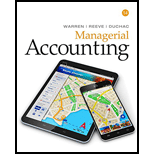
Concept explainers
A.
Determine the amount of cash paid for merchandise.
A.
Explanation of Solution
Statement of
Direct method: This method uses the basis of cash for preparing the cash flows statement.
Cash flows from operating activities: In this direct method, cash flow from operating activities is computed by using all cash receipts and cash payments during the year.
Cash Receipts: It encompasses all the cash receipts from sale of goods and on account receivable.
Cash Payments: It encompasses all the cash payments that are made to suppliers of goods and all expenses that are paid.
The below table shows the way of calculation of cash flows from operating activities:
| Cash flows from operating activities (Direct method) |
| Add: Cash receipts. |
| Cash receipt from customer |
| Less: Cash payments: |
| To supplier |
| For operating expenses |
| Income tax expenses |
| Net cash provided from or used by operating activities |
Determine the amount of cash paid for merchandise.
Therefore, the amount of cash paid for merchandise is $1,025,800.
Working notes:
Calculate increase or decrease in merchandise inventories:
Calculate increase or decrease in accounts payable:
Cash payments for purchase represents the total amount of cash paid for the purchase as well as to the accounts payable.
B.
Determine the amount of cash paid for operating expenses.
B.
Explanation of Solution
Therefore, the amount of cash paid for operating expenses is $179,170.
Working note:
Calculate increase or decrease in operating expenses / accrued expense payable:
Calculate increase or decrease in prepaid expenses:
Cash payments for accrued expense represent the total amount of cash paid for the operating expense as well as to the accrued expense payable.
Want to see more full solutions like this?
Chapter 13 Solutions
Managerial Accounting
- I need the correct answer to this general accounting problem using the standard accounting approach.arrow_forwardYou are employed by an external audit firm that is hired by JBltd, a privately owned incorporated business. Accounting records are maintained on a computer using proprietary software. You have worked on the audit for three years and this year you are in charge of the audit. Your assistant is a newly recruited business graduate who has done an accounting course but has no practical experience. Because of the small size of the company there is limited opportunity for segregation of duties. You decide, as in previous years, that the appropriate audit strategy is to obtain evidence primarily through the performance of substantive procedures. You also plan to perform the audit around the computer as the proprietary software is known to be reliable and details of all transactions and balances can be readily printed out. On arriving at the company's premises in December 2019 to perform the final audit on the 31 October 2019 financial statements, you obtain a copy of the year end bank…arrow_forwardGeneral accountingarrow_forward
 Managerial AccountingAccountingISBN:9781337912020Author:Carl Warren, Ph.d. Cma William B. TaylerPublisher:South-Western College Pub
Managerial AccountingAccountingISBN:9781337912020Author:Carl Warren, Ph.d. Cma William B. TaylerPublisher:South-Western College Pub Financial And Managerial AccountingAccountingISBN:9781337902663Author:WARREN, Carl S.Publisher:Cengage Learning,
Financial And Managerial AccountingAccountingISBN:9781337902663Author:WARREN, Carl S.Publisher:Cengage Learning, Financial AccountingAccountingISBN:9781337272124Author:Carl Warren, James M. Reeve, Jonathan DuchacPublisher:Cengage Learning
Financial AccountingAccountingISBN:9781337272124Author:Carl Warren, James M. Reeve, Jonathan DuchacPublisher:Cengage Learning College Accounting, Chapters 1-27AccountingISBN:9781337794756Author:HEINTZ, James A.Publisher:Cengage Learning,
College Accounting, Chapters 1-27AccountingISBN:9781337794756Author:HEINTZ, James A.Publisher:Cengage Learning, Financial AccountingAccountingISBN:9781305088436Author:Carl Warren, Jim Reeve, Jonathan DuchacPublisher:Cengage Learning
Financial AccountingAccountingISBN:9781305088436Author:Carl Warren, Jim Reeve, Jonathan DuchacPublisher:Cengage Learning Cornerstones of Financial AccountingAccountingISBN:9781337690881Author:Jay Rich, Jeff JonesPublisher:Cengage Learning
Cornerstones of Financial AccountingAccountingISBN:9781337690881Author:Jay Rich, Jeff JonesPublisher:Cengage Learning





